An enjoyable day of watersports starts with the driver. If you’ve never towed anyone behind your boat, or if you do it all the time, these three techniques will help make your day on the water more fun—and safe.
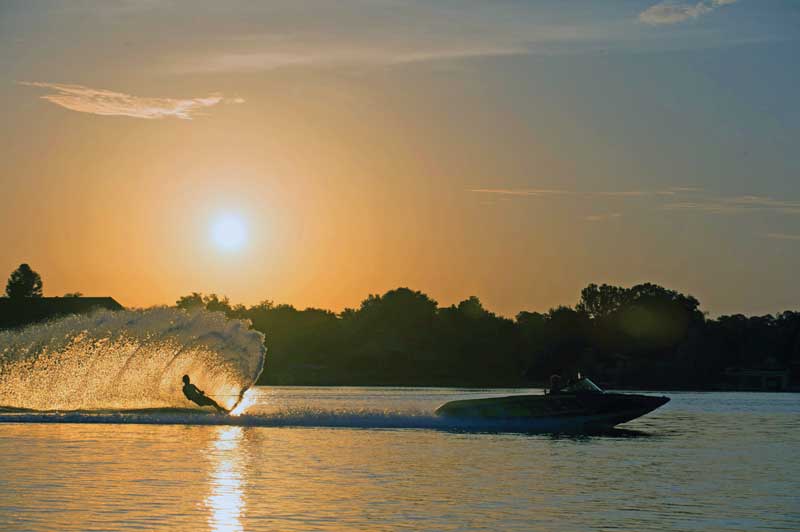
Towing A Tuber Safely
When it comes to fun on the water, few activities are more inclusive than towing a tuber behind your boat. It’s fun for all ages, can be done behind just about any style powerboat, and is straightforward to hook up. While much of this may seem like commonsense to those of us who grew up with watersports, a litany of high-profile accidents has thrust watersports safety into the spotlight. One state, Illinois, passed a new law requiring skier-down flags aboard boats, while others have proposed increasing criminal penalties for negligent operators. But towing safely isn’t hard. Just keep these three things in mind.
Keep your distance. The most important thing to remember when towing anyone behind the boat, whether on skis, a wakeboard, or on a tube, is to keep a safe distance from both fixed objects like docks, channel markers, bulkheads, or shorelines—and from shallow water on both sides of the boat. While ropes made for towing tubers are sometimes shorter, a full-length ski rope measures 75-feet long. Add another few feet to account for any yoke, or tow bridle, plus the length of the tube itself, and it’s best to consider 100 feet as a bare minimum safe distance. A tumbling tuber ejected from his or her ride will often travel an impressive distance above or on top of the water, so more room is safer. If you imagine a swath of water 300 feet wide (the length of a football field) with the boat at the center as your “safe zone” and steer to prevent anything from entering that zone, you’ll be off to a good start. Keep in mind that tubers, more than skiers or wakeboarders, are at the mercy of the driver, because they can’t steer the tube, or release the line.
Speed is relative. If you’ve ever experienced the exhilaration of being whipped through a tight turn at the end of a ski rope, you know firsthand that the tube absolutely hums along, skipping lightly across the water. But it may surprise you to know just how much faster the tube is traveling than the boat. The key to this is the length of the ski rope, which puts the tube through a much greater length arc than the boat itself. In a full turn, particularly a tight one, the tube may travel twice the distance of the boat, which means it’s travelling twice as fast as well. So, while you, the skipper, may be experiencing that turn at a sedate 20 mph, your rider feels the water rushing by at 40 mph or more, making it doubly important to avoid those aforementioned solid objects.
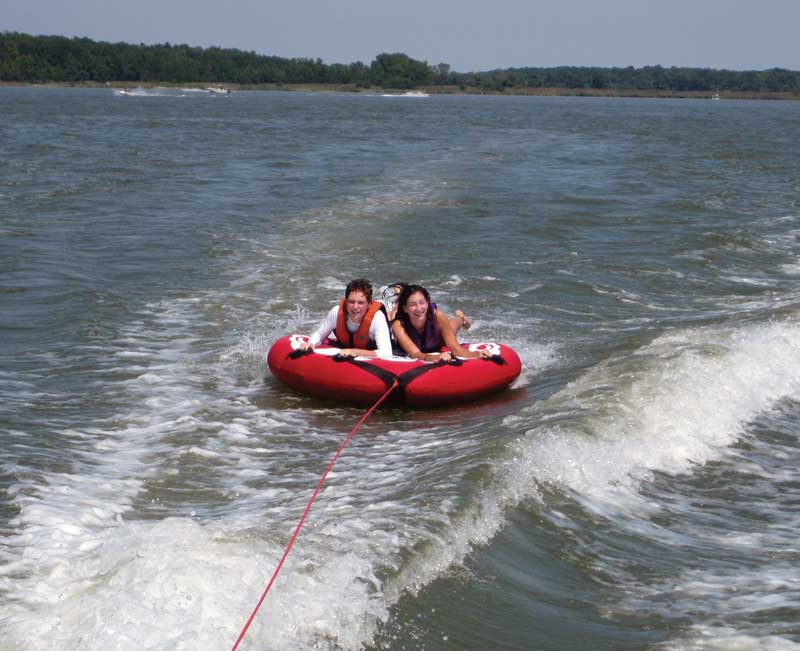
Be aware of other boats. Other than striking a dock or piling, perhaps the greatest danger to a tuber is other boats, particularly after a rider falls off the tube. Unlike skiing, tubing doesn’t require flat water, so you often see tubers in more crowded waters. It can be difficult to see someone bobbing in the water waiting to be picked up, even if the tuber is wearing a brightly colored life jacket. Other boaters don’t expect swimmers away from shore where you’re likely to be towing, and they can easily fail to spot a head just above water. Skiers and wakeboarders are taught to hold their ski or board up out of the water to increase visibility. Tubers don’t have this option. For this reason, some states require boaters to display an orange flag on the boat when a rider is down in the water.
To increase the safety of your tubers, avoid towing in congested areas, busy channels, and the like, and pay attention to other boats transiting the area. Their operators may not be watching you or paying attention to the erratic movements you’re making while trying to give your tuber a thrilling ride. Your spotter, a second adult in the boat responsible for keeping an eye on the rider, will allow you to focus on driving, and not the rider.
Retrieving Riders Safely
The easiest way to keep everyone who goes over the side to ski, wakeboard, or tube safe is to establish a routine around how you approach and pick up a downed skier and stick to it. You never want to expose your crew to a moving prop, so your routine should focus on bringing the boat close enough to board, but only after cutting off the engine. This means knowing a few things about your boat, including how it handles without power, where the boarding ladder is installed, or where a portable one works best aboard, what your close-in visibility is like from the helm, and how the boat settles into a drift in a light breeze. Alternatively, you can bring the rope back to your skier, and then shut off the engine and pull them to the boat.
The approach. Ideally, you want to return to a downed skier as quickly as possible, putting the boat between them and any passing boat traffic (Your spotter should always maintain a clear view of the skier, so you can watch other boats). But you also need to approach the person in the water in a controlled manner, being mindful of your wake and its effects if you circle tightly. You don’t want to come in hot, cut the engine, and drift up on your skier only to have your wake push the boat on top of them. When possible, for best visibility, approach with the skier to the starboard side (or the same side as the helm), turn off the engine as you draw alongside, then turn to starboard, letting the boat’s momentum carry you into a gentle turn that should slow the boat in front of the skier. In a perfect world, you’d be on the upwind side (the wind on the opposite side of the boat from the skier), so any breeze would move the boat to the skier, and your boarding ladder would be on the same side as the skier. It’s always preferable not to require the skier to cross the transom to board the boat. Even with the engine off, a prop or lower unit is no fun to kick or bang into as you swim by.
Off means OFF. It doesn’t mean neutral. Too many prop-strike stories start with the phrase, “I thought it was in neutral.” An inadvertent bump of the throttle, or just a sticky throttle with a linkage out of adjustment, can easily result in a motor that’s in gear at precisely the wrong moment. If you’ve turned the motor off, there can be no mistakes.
After they board. Similarly, you never want to start the engine until you, the captain, have visually confirmed your skier is aboard, the ladder has been stowed, and the ski rope is clear of the prop or outdrive. It’s not enough to ask about these things; turn around and see for yourself. The few seconds it takes each time you retrieve a skier are well worth it if it prevents you from sucking the tow rope into the prop, or worse.
How To Return the Tow Rope to a Downed Skier
“Wipeout! Skier down!” shouts your spotter. Those words cause you to spin the wheel, and start looking for your downed skier, bobbing in the water, waiting for another go. But what’s the best way to get the ski rope handle back in their hands?
Not as straightforward as it looks. You’ve got a couple of issues to overcome. First, you can’t just circle the skier and expect them to swim out to the rope. For one thing, it’s difficult to move at all with skis on in the water, and the more effort they spend swimming, the less energy they’ll have for fun. Secondly, you can’t turn too tightly or you’ll run over your own rope. What you need to execute is a tight U-turn, off-set with the skier at the bottom of the U (see figure 1).
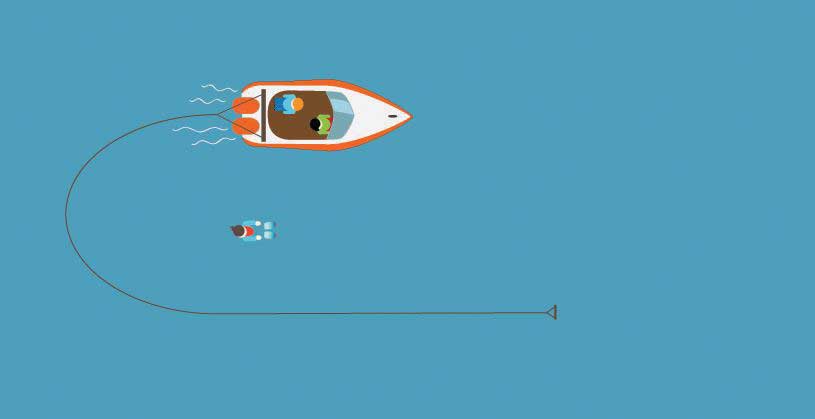
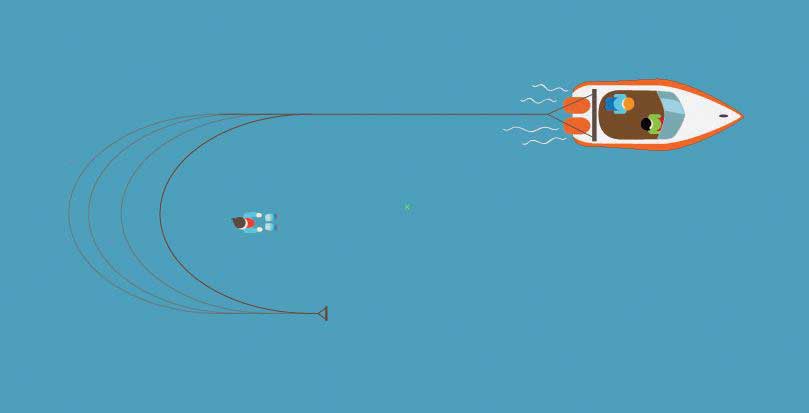
To do this safely keep these tips in mind:
- Your spotter should keep their eye on the skier at all times as you turn around them in the water, keeping the boat a safe distance away. You should also do so, but with a lookout for other boats as well.
- Keep the throttle at idle, so you’re just making headway (dead slow).
- You can “pinch” the U at the end of your turn if need be, to bring the rope back more quickly. But make sure you don’t run over the handle.
- The rope’s handle is what makes this U-shape effective. It acts as an anchor of sorts, creating more drag in the water than the line to which it’s attached. When you make the turn at the bottom of the U, the handle’s drag makes the bottom of the U-shape slip through the water, almost like a noose tightening, coming closer to the skier than the boat originally passed. (See figure 2). Done correctly, the line will end up passing behind their back. All they have to do is lie back and wrap an arm over it, then pass it overhead. At that point it’s best to have the boat in neutral, so you aren’t pulling them through the water before they’re ready.
- This technique will also work with most tubes, though those riders are free to swim to the tube if you just drag it past them. It also should be noted that crew-overboard devices such as a Life Sling or life ring on a long line can be brought to a person’s hands in the same manner, so sailors should practice this maneuver as well.
Spotters Required
When towing anyone behind your boat, whether on a tube, board, or skis, you must (should) have at least one spotter aboard to keep track of your skier and relay instructions to the driver, such as speed up, slow down, and so on. And it’s important for the driver, spotter, and skier to all know and go over the signals before starting. When everyone knows their role and what to expect, things go better.
In states that require a skier down flag, the spotter would be responsible for holding it aloft when the skier falls. Some states require a spotter for each person being towed, and there are often minimum ages (kids don’t usually count). To find out the laws in your state go to NASBLA.org and click on State Boating Laws under the Resources tab. (In Maryland, a skier-down flag is not required, but a spotter is.)
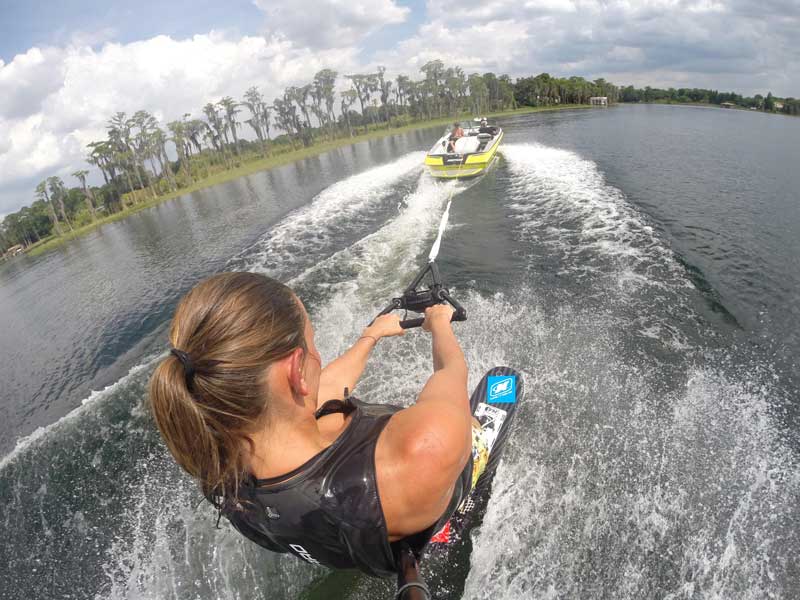
Loaner Lifejackets
The BoatUS Foundation is dedicated to putting more kids in properly fitting life jackets. The Life Jacket Loaner Program for Kids is just one of the many ways BoatUS keeps kids safe on the water. There are more than 575 loaner sites throughout the country. Find one near you at boatus.org/life-jacket-loaner.
By Michael Vatalaro
This article was reprinted with permission from BoatU.S. Magazine, flagship publication of the membership organization Boat Owners Association of The United States (BoatU.S.). For more expert articles and videos to make your boating, sailing, or fishing better, visit BoatUS.com.